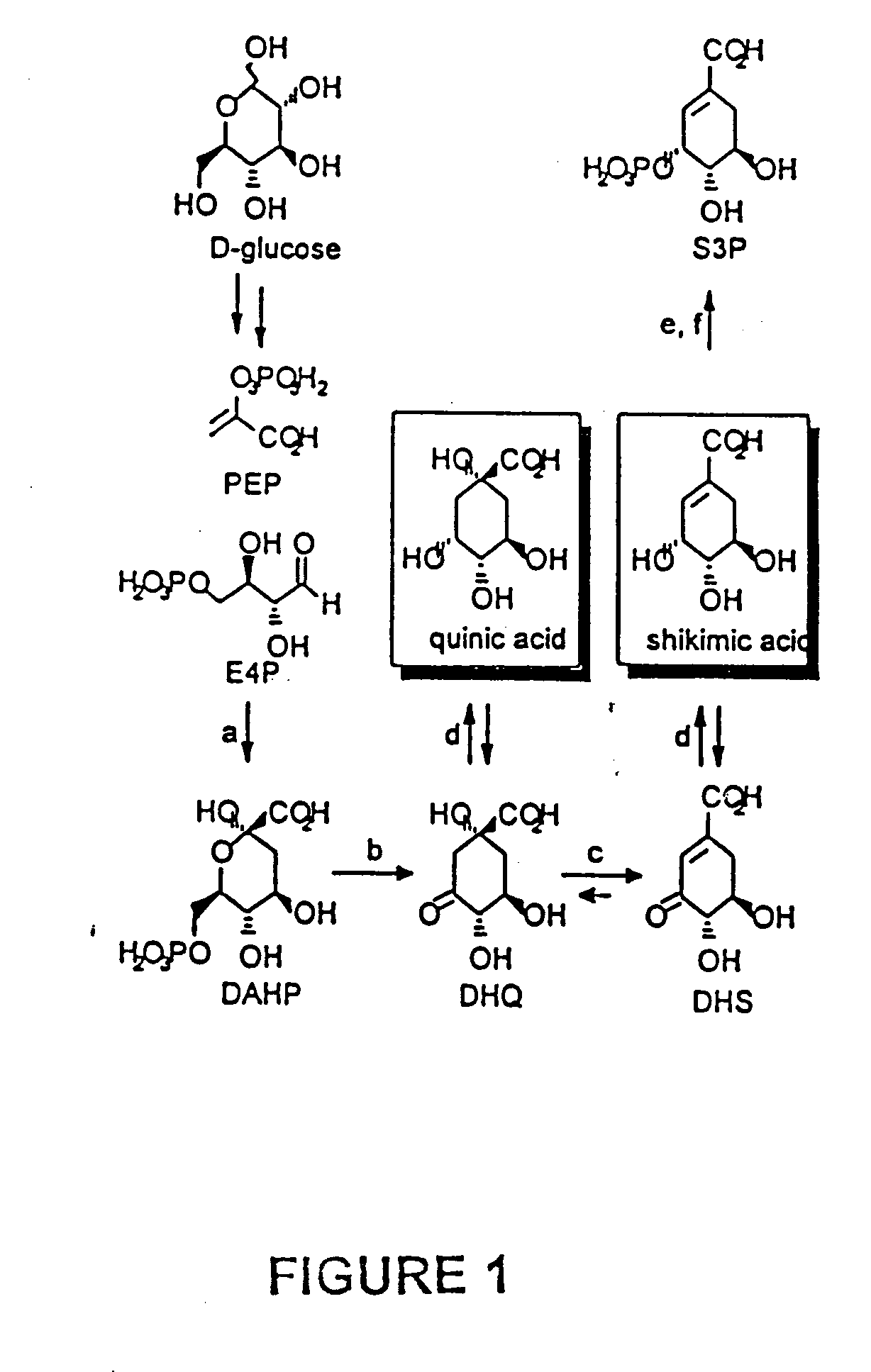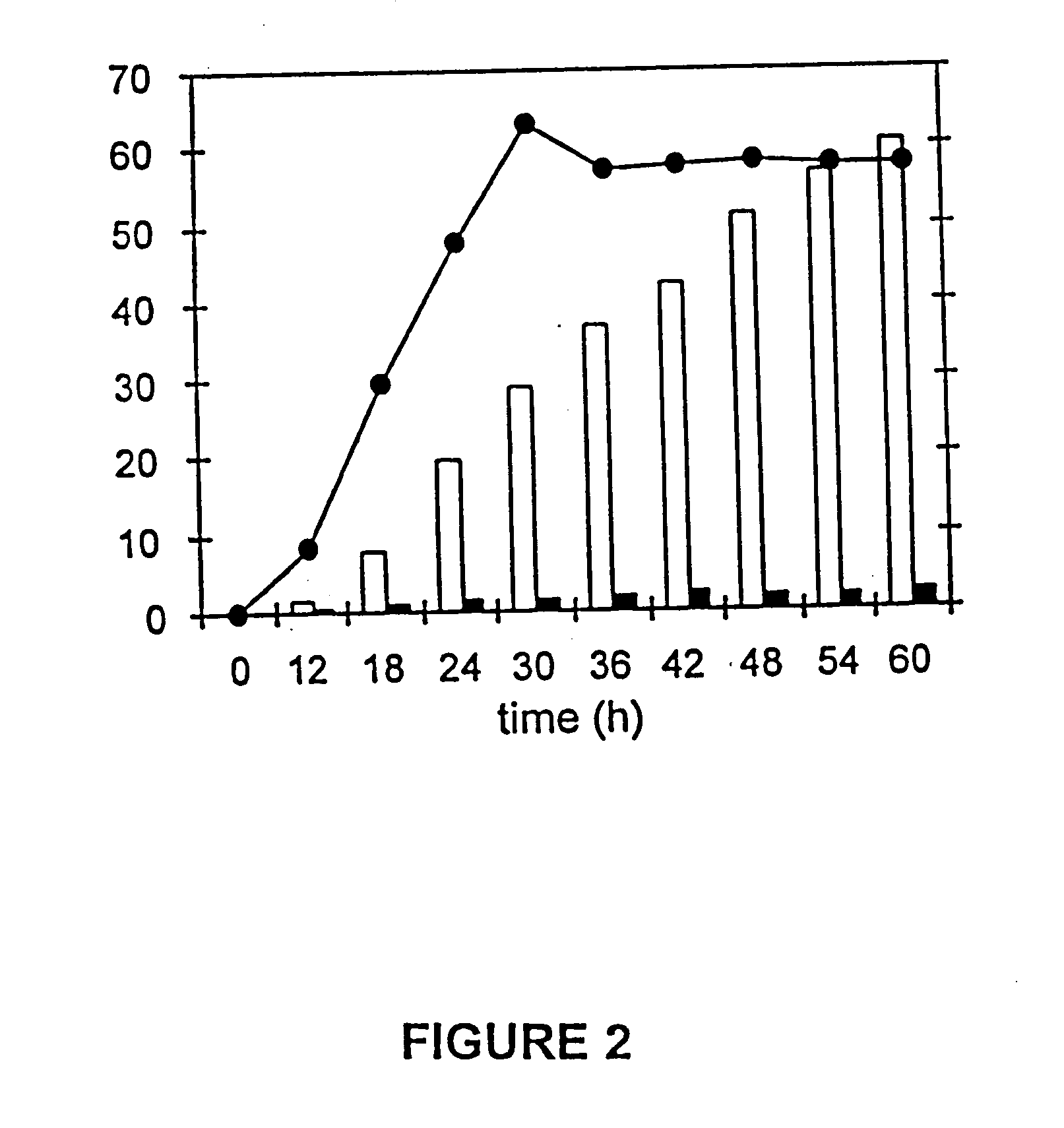Biocatalytic synthesis of quinic acid and conversion to hydroquinone
a quinic acid and biocatalytic technology, applied in the field of quinic acid production, can solve the problems of high reagent and hazardous waste, high cost of isolating quinic acid from such sources, and low specific activity of quinate dehydrogenas
- Summary
- Abstract
- Description
- Claims
- Application Information
AI Technical Summary
Benefits of technology
Problems solved by technology
Method used
Image
Examples
specific example 1
Synthesis of Quinic Acid by Shikimate Dehydrogenase
I. Results
[0038] Culturing SP1.1 / pKD12.112 for 42 h with Kc=0.1 resulted in the synthesis of 27.2 g / L of shikimic acid, 12.6 g / L of quinic acid, and 4.4 g / L of 3-dehydroshikimic acid (DHS). DHS accumulation reflected the expected feedback inhibition of shikimate dehydrogenase by shikimic acid. Draths, K. M. et al., J. Am. Chem. Soc. 114:9726 (1992); Dell, et al., J. Am. Chem. Soc. 115:1158 (1993). By contrast, quinic acid biosynthesis was surprising given the absence in E. coli of quinic acid dehydrogenase which catalyzes 3-dehydroquinate and quinic acid interconversion.
[0039] Quinic acid formation was further explored by collecting SP1.1 / pKD12.112 cells from the fermentor after 24 h. Washed cells were resuspended in fresh fermentation medium containing shikimic acid and shaken. As shown in FIG. 3, formation of quinic acid (solid bars) and 3-dehydroshikimate (hatched bars) along with a corresponding decrease in shikimic acid (op...
specific example 2
Synthesis of Quinic Acid from Glucose
I. Results
[0047] Microbes were cultured under fed-batch fermentor conditions at 33° C., pH 7.0, with dissolved oxygen maintained at a set point of 10% air saturation. D-Glucose addition was controlled by dissolved O2 concentration and was a critical control parameter during syntheses of shikimic and quinic acids. When dissolved oxygen levels exceeded the set point value indicating decreased microbial metabolism, the rate of D-glucose addition was increased. When dissolved oxygen levels declined below the set point value indicating increased microbial metabolism, the rate of D-glucose addition was decreased. Proportional-integral-derivative control (PID) was used to control the rate of D-glucose addition.
[0048] QP1.1 / pKD12.112 was cultured for 60 h under fed-batch fermentor conditions at 37° C., pH 7.0, dissolved oxygen at 10% of saturation and an initial glucose concentration of 23 g / L. Extracellular accumulation of quinic acid began in early...
specific example 3
Synthesis of Hydroquinone from Quinic Acid with Acidified NaOCl
I. Results
[0059] Hydroquinone was synthesized from quinic acid as shown in the synthetic scheme of FIG. 4. Quinic acid was oxidized to 3(R),4(S),5(R)-trihydroxycyclohexanone 1 upon reaction with acidified (H2SO4) commercial bleach (NaOCl). After quenching excess oxidant with isopropanol E, heating 1 afforded hydroquinone via intermediacy of cyclohexanones 2 and 3 (FIG. 4). The progress of the reaction upon heating with respect to time is shown in FIG. 5. As trihydroxycyclohexanone 1 (solid diamonds in FIG. 5) decreases, initial increases are observed for cyclohexanones 2 and 3 (open squares and shaded triangles, respectively, in FIG. 5). As the reaction progresses, the intermediates decrease and hydroquinone is formed (-x- in FIG. 5).
II. Methods
[0060] General Chemistry. 1H NMR spectra were recorded at 300 MHz on a Varian Gemini-300 spectrometer. Chemical shifts for 1H NMR spectra are reported (in parts per million)...
PUM
| Property | Measurement | Unit |
|---|---|---|
| temperature | aaaaa | aaaaa |
| pH | aaaaa | aaaaa |
| concentration | aaaaa | aaaaa |
Abstract
Description
Claims
Application Information
 Login to View More
Login to View More - R&D
- Intellectual Property
- Life Sciences
- Materials
- Tech Scout
- Unparalleled Data Quality
- Higher Quality Content
- 60% Fewer Hallucinations
Browse by: Latest US Patents, China's latest patents, Technical Efficacy Thesaurus, Application Domain, Technology Topic, Popular Technical Reports.
© 2025 PatSnap. All rights reserved.Legal|Privacy policy|Modern Slavery Act Transparency Statement|Sitemap|About US| Contact US: help@patsnap.com



